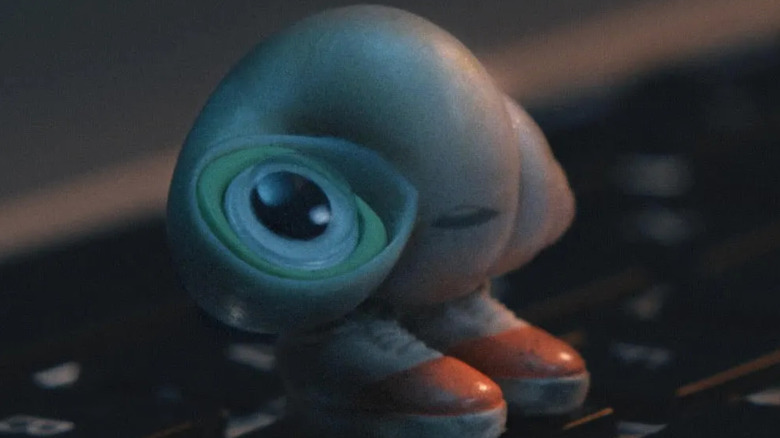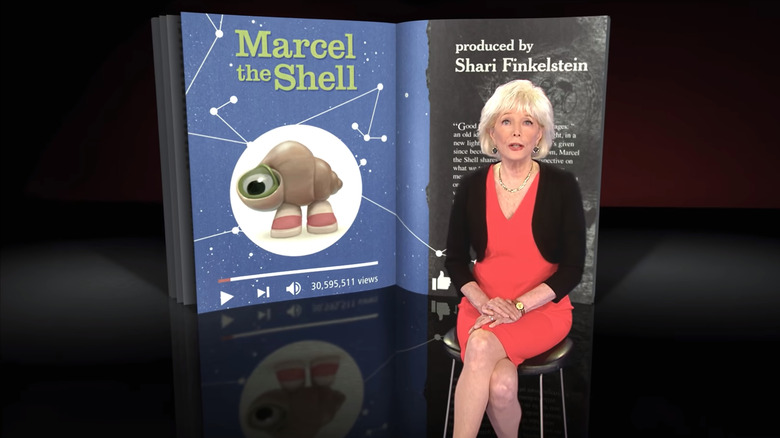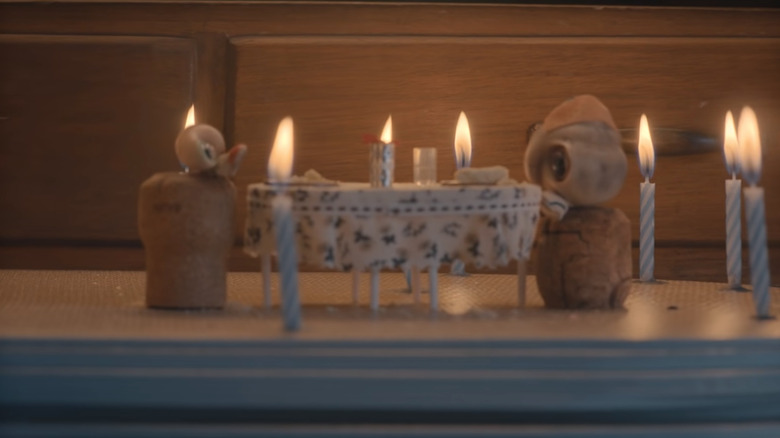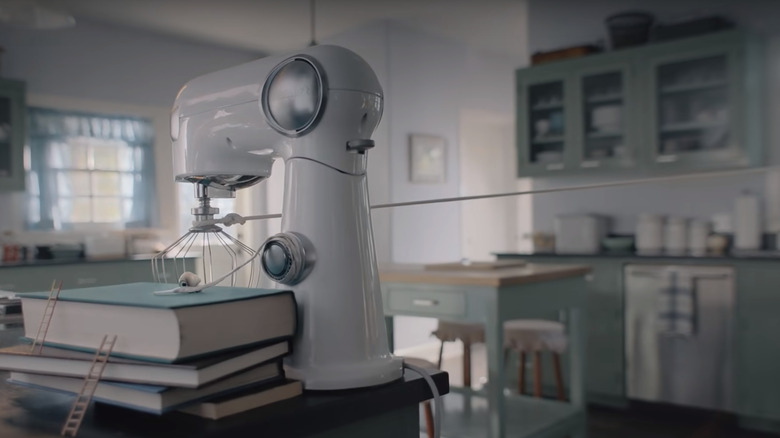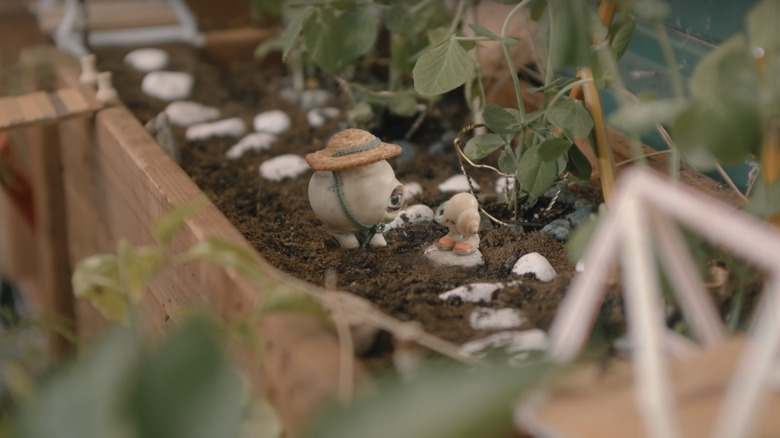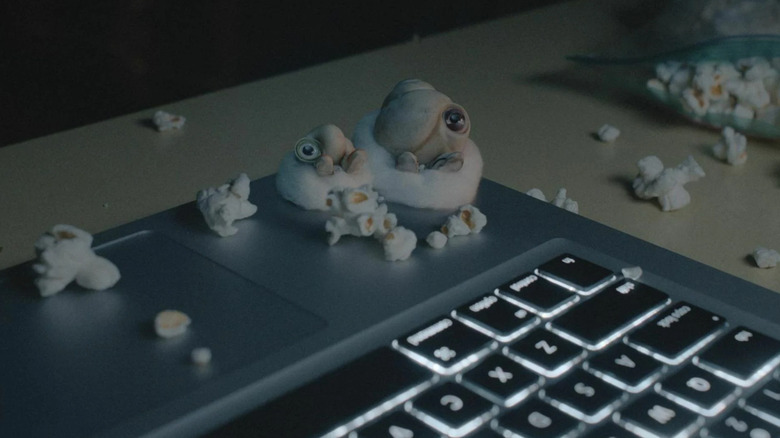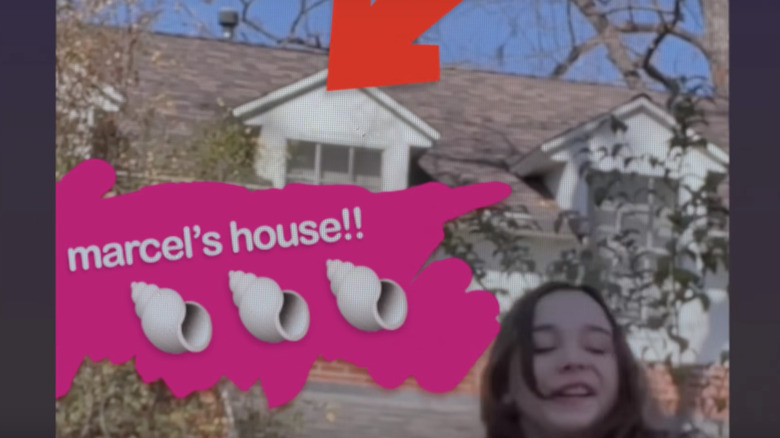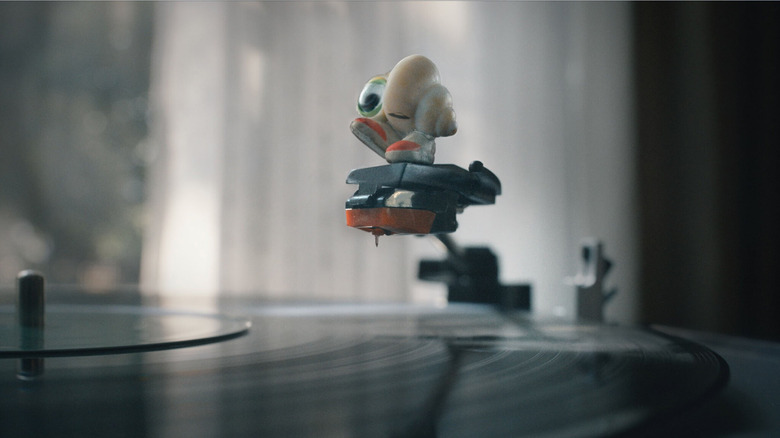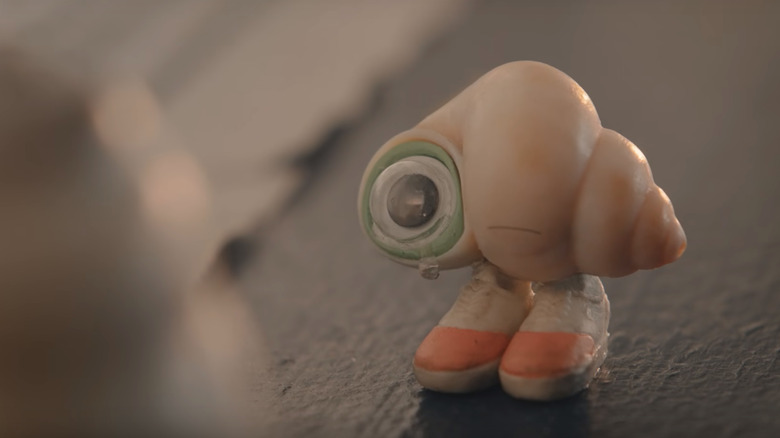Marcel The Shell With Shoes On Details You Only Notice As An Adult
This article contains SPOILERS for "Marcel the Shell with Shoes On."
You could probably guess that a kids' film released by A24 — the indie distributor best known for edgy horror films like "Hereditary," Oscar-winning dramas like "Moonlight," and super-weird genre-benders like "Everything Everywhere All at Once" – isn't going to be your typical kids' film. "Marcel the Shell with Shoes On," the theatrical feature based on the hit viral stop-motion short films created by Dean Fleischer-Camp and Jenny Slate, is the sort of film that can serve as a child's first introduction to arthouse cinema, and it will entertain viewers of all ages.
The charms of the film, about a tiny anthropomorphic shell (voiced by Slate) searching for his lost family with the help of his grandma Connie (Isabella Rossellini) and a documentary filmmaker (Fleischer-Camp, playing himself), should hold universal appeal. However, parents and older viewers will likely find themselves appreciating different aspects of the film than their children. Some of these are jokes and references that will fly over younger viewers' heads, but more than anything, adults will be extra appreciative of just how unique the film's artistry and mature thematic concerns are in its genre.
The filmmakers' divorce almost certainly influenced the movie
Dean Fleischer-Camp and Jenny Slate first came up with the idea for "Marcel the Shell with Shoes On" while attending a wedding together (via AP). After their cartoon became a viral phenomenon in 2010, the two got married themselves in 2012, only to divorce in 2016. The split was fortunately amicable, and they remained close enough to make the "Marcel the Shell with Shoes On" movie. In many ways, the movie feels directly impacted by their divorce.
Fleischer-Camp plays himself in the movie as the documentarian following Marcel's life, and this fictionalized Dean has also been divorced. Dean is asked about his divorce multiple times, being cagey about the details. Crumbling relationships also play a dramatic role in the story's inciting incident: the rest of Marcel and Connie's family was taken away in a backpack by a man leaving his girlfriend after an argument. Even before the separation occurs, this is an intense scene, the volume of the fight escalated to capture the sheer terror of the shells' perspective.
60 Minutes plays a big role in the story
Before Dean exposes him to the internet, practically all of Marcel's knowledge of the outside world comes from watching television, and there's one show in particular he loves so much that he simply refers to it as "the show." This show is "60 Minutes," the long-running investigative journalism series that's aired every Sunday night on CBS since 1968.
It's an unusual favorite for a tweenage shell, but it seems family memories are the reason. His whole family used to watch it together, and it's still a weekly tradition for him and Connie. Connie particularly loves reporter Lesley Stahl, because she is "fearless." Stahl herself enters the story after being moved by Marcel's quest to find his family, and while Marcel is initially indecisive about whether he wants further media exposure, he ultimately agrees to go on the show. Stahl and her team are able to locate Marcel's family and reunite them.
The struggles of caring for elderly relatives
Marcel is a young shell tasked with the job of caring for his grandma. It's a lot of responsibility, and while there are undoubtedly kids who are in similar boats, it's a situation that's even more widely relatable to adults who have to deal directly with their loved ones aging. Connie is a wise shell who gives Marcel plenty of helpful advice, but her health has both good days and bad days.
Sometimes Connie is mentally sharp and physically active. Other days, she can't remember conversations from just a few minutes ago and doesn't even eat her meals. When Marcel goes out with Dean on a ride to search for the man who took his family away, he tries to keep Connie inside a strainer so she won't hurt herself. This attempted restraint fails, and she ends up cracking her shell from a bad fall. Her health declines after the fall, and eventually she dies. Her death will leave viewers of all ages sad, but those with greater personal experience will be extra heartbroken.
He built a rope out of WHAT!?!
It takes a lot of work for two tiny shells to navigate a house all by themselves, and Marcel has built a lot of creative contraptions to accomplish basic tasks. Watching these machines in action is fun and whimsical — enough so that you can forgive just how gross a lot of these devices actually are.
Marcel relies on a lot of rope to connect objects in different parts of the house, but he doesn't exactly have that much rope lying around, so he has to made some it himself ... with hairs found clogged in the bathroom drain.
Kids will get the gross-out humor, but adults may find themselves extra disturbed by Marcel's description of thicker "hearty hairs" as the best material for rope building. Is this cute little shell talking about making rope out of pubic hair? That's certainly an implication of that line, and one that's probably best not to think too hard about.
Who said that quote?
Marcel is a fount of positivity, almost always having the right thing to say for the camera in an awkward situation. In one scene early in the film, he repeatedly fails to catapult pieces of fruit onto the shelf. Rather than feel bad about the repeated failures, he chooses to feel good about himself for even trying, repeating the famous inspirational quote from hockey player Wayne Gretzky, "You miss 100 percent of the shots you don't take."
Unlike Michael Scott from "The Office," Marcel isn't one to plagiarize other people's quotation, but he has trouble remembering the name of the man who originally said it. Sputtering through various "W" sounds, he cracks himself up trying to figure out the name. The closest he comes to actually saying "Wayne Gretzky"? "Whale Jetski." It seems that while Marcel and Connie watch sports together, neither are particularly knowledgeable about them; at one point, Connie attempts to describe the sports she watches without ever actually knowing the names of them.
It's like Sister Act
Marcel's pop culture knowledge, primarily informed by his evenings watching whatever is showing on TV, comes up infrequently in random places throughout "Marcel the Shell with Shoes On." It would seem that some TV station must have been rerunning the 1992 Whoopi Goldberg comedy "Sister Act" recently, because Marcel talks about it despite said older movie being a pretty unlikely frame of reference for your average present day kid.
The context of the reference is in making a comparison between the movie's plot, in which Goldberg's lounge singer-turned-nun "Sister Mary Clarence" inspires people to clean up and revitalize a run-down neighborhood, and how Connie has managed her gardening. While Marcel himself is uncomfortable around insects, Connie cares for insects who have become sick or injured, and in turn, they help with pollinating her garden and turning the place into something she can be truly proud of.
Drug references
2022 has been a year of a surprising number of drug references in PG-rated films. In the past, such references would ordinarily get films an automatic PG-13 at minimum, but it seems things are changing. "Turning Red" included a scene with Ming Lee berates a convenience store employee by accusing him of "doing drugs," and now "Marcel the Shell with Shoes On" contains two separate drug jokes.
The first of these jokes comes in the form of a meme Marcel finds of himself after his video goes viral, featuring a picture of the shell with the caption "When the kush hit." Marcel and Connie are both confused by what this meme means, and Isabella Rossellini's utterly baffled line reading sells this as one of the funniest bits of the film to a certain audience.
The second joke is one parents may have reason to be more concerned about: when Dean finds Marcel eating random pills in the bathroom, Marcel can't actually tell the filmmaker what the pills are and passes off the behavior as just "how I live." The nutritional demands of sentient shells remains an amusing source of confusion, but this is where the "Parental Guidance" rating comes in handy — you don't want your kids to imitate this risky behavior.
The downside of going viral
How fitting that the plot of a movie based on a viral video is in large about the experience of going viral. Marcel is excited enough when dozens of people watch Dean's documentary about him on YouTube; by the time the view count reaches the multi-millions, Marcel is shocked to realize that many people even exist in the world. As he becomes a celebrity, we see a montage of news reports, reaction videos, memes, and embarrassing tattoos, most of which appear to be actual responses to the early 2010s popularity of the original "Marcel" shorts.
This blast of early 2010s nostalgia gives way to some pointed and relevant commentary on the nature of internet celebrity and online parasocial relationships. Marcel initially believes his popularity means he's making new friends who could help him with locating his family, but that's not how fame works. These aren't friends, but just fans and followers who are coming to Marcel's livestreams for content rather than connection. The most obnoxious of these fans turn his house into a tourist site against his will, constantly taking selfies outside and making a mess of the yard.
This was clearly hard to animate
Stop-motion animation may very well be the most labor-intensive form of filmmaking there is. While "Marcel the Shell with Shoes On" uses simpler character designs than other stop-motion films from the likes of Henry Selick or Wes Anderson, the production had additional complications due to the combination of animated characters and live-action aspects. The audio had to be locked down before the shoot even began, and then had to do two separate shoots: the live-action elements were filmed in 2019 and the animated elements in 2020 (via Animation Magazine).
Animation director Kirsten Lepore led a crew of 50 animators working on 10 different sets simultaneously in order to complete the film. One aspect that stands out as particularly striking to those familiar with stop-motion is that the documentary-style handheld camera is constantly moving. How on Earth did they manage to match that cinematography with characters who have to move one frame at a time? It all looks seamless enough on-screen that it appears less showy than other stop-motion movies, but it's pretty mind-blowing to those familiar with how animation works.
Pandemic-era resonance
"Marcel the Shell with Shoes On" was already fully scripted and half-completed by the time the COVID-19 pandemic temporarily halted its production, so any topicality to its subject matter is a happy accident rather than something intentional. Even so, it's hard to come to this story — one about a kid who once lived in a thriving community but has now gotten used to the company of just a single family member and has to engage with social media in order to seek outside connections — and not feel like this is extremely relevant for the current moment.
Truth be told, a lot of perceptive kids in the audience will likely pick up on these themes. What makes it more intense from an adult perspective is that it's a film that offers older viewers a chance to really look at social isolation from the perspective of a child. For kids who've been living through the pandemic for huge chunks of their lives, this all might register as obvious, but for adults, it feels genuinely special as an empathy-expanding work of art.
